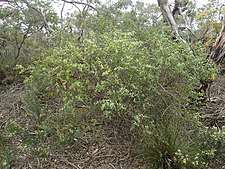Hakea ferruginea
Hakea ferruginea, commonly known as rusty hakea,[2] is shrub in the family Proteacea. It has flat leaves and white to cream-coloured flowers from late winter to mid-summer and is endemic to Western Australia.


| Hakea ferruginea | |
|---|---|
 | |
| Hakea ferruginea growing near the Stirling Range National Park | |
| Scientific classification | |
| Kingdom: | Plantae |
| Clade: | Tracheophytes |
| Clade: | Angiosperms |
| Clade: | Eudicots |
| Order: | Proteales |
| Family: | Proteaceae |
| Genus: | Hakea |
| Species: | H. ferruginea |
| Binomial name | |
| Hakea ferruginea | |
 | |
| Occurrence data from AVH | |
Description
Hakea ferruginea is an erect, rounded, non-lignotuberous shrub which typically grows to a height of 1 to 4.5 metres (3 to 15 ft). The branchlets are hairy and the leaves are arranged alternately.[3] The pale green leaf blade is flat, narrowly to broadly egg-shaped or elliptic and is 1.5 to 8.5 centimetres (0.6 to 3.3 in) in length and 1.2 to 2.7 cm (0.47 to 1.06 in) wide.[4] It blooms from July to November and produces white-cream flowers.[3] The solitary inflorescences contain 16 to 20 flowers with a cream-white perianth. After flowering obliquely ovate shaped beaked fruit that are 2 to 3.1 cm (0.79 to 1.22 in) in length and 1.1 to 1.8 cm (0.43 to 0.71 in). The black to brown seeds within have a narrowly ovate or elliptic shape with a wing down one edge.[4]
Taxonomy
Hakea ferruginea was first formally described by the botanist Robert Sweet in 1827 and the description was published in Flora Australasica.[5][6] Hakea repanda R.Br. is a synonym.[7][8] The specific epithet is a Latin word meaning "rust-coloured" or "rusty",[9] referring to the colour of new growth.[4]
Distribution
Rusty hakea is found in a small area in the Wheatbelt and an area along the south coast of the Great Southern and Goldfields-Esperance regions of Western Australia where it grows in sandy, rocky loam or clay soils.[3] The shrub is often part of mallee heath or open forest communities.[4]
Conservation status
Hakea ferruginea is classified as "not threatened" by the Western Australian Government Department of Parks and Wildlife.[3]
References
- "Hakea ferruginea". Australian Plant Census. Retrieved 9 April 2020.
- "Rusty Hakea". APNI. Retrieved 14 October 2018.
- "Hakea ferruginea". FloraBase. Western Australian Government Department of Parks and Wildlife.
- "Hakea ferruginea". Fact Sheet. Government of South Australia. Retrieved 11 September 2018.
- "Hakea ferruginea". APNI. Retrieved 14 October 2018.
- "Flora Australasica". Internet Archive. Retrieved 9 April 2020.
- "Hakea ferruginea Sweet". Atlas of Living Australia. Global Biodiversity Information Facility. Retrieved 14 October 2018.
- Sweet, Robert (1827–1828). Flora Australasica (PDF). Piccadilly: James Ridgway. p. 45. Retrieved 14 October 2018.
- Brown, Roland Wilbur (1956). The Composition of Scientific Words. Washington, D.C.: Smithsonian Institution Press. p. 168.